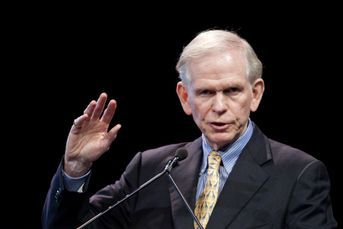Fed tapers another $10B a month; stocks extend losses
Slight economic improvement keeps central bankers on track as they commit to keeping target interest rate near zero.
The Federal Reserve will trim its monthly bond buying by $10 billion to $65 billion, sticking to its plan for a gradual withdrawal from departing Chairman Ben S. Bernanke’s unprecedented easing policy.
“Labor market indicators were mixed but on balance showed further improvement,” the Federal Open Market Committee said Wednesday in a statement following a two-day meeting in Washington that was the last for Mr. Bernanke, who will be succeeded by Vice Chairman Janet Yellen on Feb. 1. “The unemployment rate declined but remains elevated.”
Policymakers pressed on with a reduction in the purchases intended to speed a recovery from the worst recession since the Great Depression, even after payroll growth slowed in December and amid a rout in emerging-market currencies. Some officials have expressed concern that the Fed’s record $4.1 trillion balance sheet could help create asset-price bubbles.
Stocks declined further after the news. The S&P 500 lost 1.2% to 1,771.86 and the Dow Jones Industrial Average dropped 202.90 points, or 1.3%, to 15,725.66. Ten-year Treasury note yields were at 2.72% from 2.75 late Tuesday.
The Fed left unchanged its statement that it will probably hold its target interest rate near zero “well past the time” that unemployment falls below 6.5%, “especially if projected inflation” remains below the committee’s longer-run goal of 2%.
MONITORING INFLATION
The Fed repeated the inflation “persistently below its 2% objective could pose risks to economic performance and it is monitoring inflation developments carefully for evidence that inflation will move back toward its objective over the medium term.”
The central bank’s preferred gauge of consumer prices climbed 0.9% in the year through November and hasn’t exceeded the Fed’s goal since March 2012.
Bond purchases will be divided between $35 billion in Treasuries and $30 billion in mortgage debt beginning in February, the Fed said. It repeated that purchases are not “on a preset course.”
It was the first meeting with no dissent since June 2011, showing Fed officials coalescing around the central bank’s tapering strategy as Ms. Yellen prepares to take over the chairmanship from Mr. Bernanke.
Fed district bank presidents rotate voting on monetary policy each year, with Cleveland’s Sandra Pianalto, Philadelphia’s Charles Plosser, Richard Fisher of Dallas and Narayana Kocherlakota of Minneapolis voting in 2014. Fed governors hold permanent votes, as does the president of the Federal Reserve Bank of New York, who serves as FOMC vice chairman.
TEST PROGRAM
Even as they maintain stimulus, central bankers are planning for the end to the era of low interest rates. In a technical note Wednesday, the Fed said it would continue testing a program designed to prevent short-term market interest rates from falling too low. The program, called an overnight reverse repurchase facility, was first approved in September.
Economists surveyed by Bloomberg forecast the Fed will continue tapering at each meeting and end the program no later than December.
SET COURSE
“Once you set out on a course, it’s costly to deviate from that course,” said Benjamin Mandel, an economist at Citigroup Inc. who formerly worked at the New York Fed. “It’s costly in terms of credibility and predictability.”
The Fed on Dec. 18 announced its first reduction in bond purchases, by $10 billion, and Mr. Bernanke outlined the strategy for tapering at a press conference, the last of his eight-year tenure.
“If we’re making progress in terms of inflation and continued job gains, then I imagine we’ll continue to do probably at each meeting a measured reduction,” he said.
Since then, a Labor Department report showed payrolls in December rose at the slowest pace in almost three years, partly reflecting the impact of bad weather. The unemployment rate declined to 6.7%, a five-year low, as people left the labor force.
The report didn’t signal a major labor market shift, Fed President Jeffrey Lacker told reporters on Jan. 10. An opponent of bond purchases by the Fed, Mr. Lacker doesn’t vote on policy this year.
Other data have shown continued strength in an economy that expanded at a 4.1% annual pace in the third quarter, the most in almost two years.
Retail sales climbed for the ninth straight month in December as frigid temperatures prodded Americans to buy discounted winter clothing and shop online for the holidays. Industrial production last month capped the strongest quarter since 2010.
“The Fed’s going to be feeling fairly good about the economy,” said Bluford Putnam, chief economist at CME Group Inc., owner of the world’s largest futures market. “Even though the last employment data were a disappointment, most people attribute it to noise, and other indicators about the economy are looking good.”
Emerging-markets turmoil has pushed Treasury yields lower as investors seek the safety of U.S. government debt. The yield on the 10-year Treasury note was 2.75% Tuesday, retreating from a more- than-two-year high of 3.03% on Dec. 31.
Corporate earnings may support share prices. About three-fourths of S&P 500 companies have exceeded forecasts for fourth-quarter earnings, according to data compiled by Bloomberg.
(Bloomberg News)
Learn more about reprints and licensing for this article.








